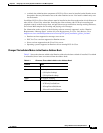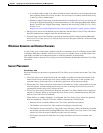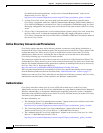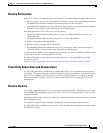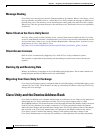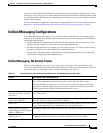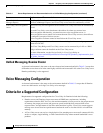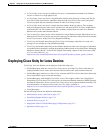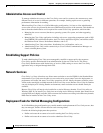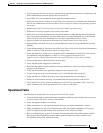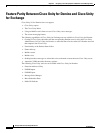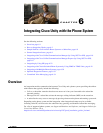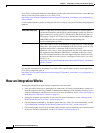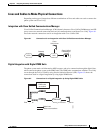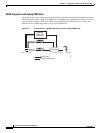
5-11
Design Guide for Cisco Unity Release 5.x
OL-14619-01
Chapter 5 Designing a Cisco Unity System with Domino as the Message Store
Deploying Cisco Unity for Lotus Domino
• A Cisco Unity server can service mailboxes on up to a recommended maximum of ten Domino
servers or clusters in a single physical site.
• A Cisco Unity server can service a single Domino address book (directory or Names.nsf file) for
local Cisco
Unity data (data for subscribers homed on the local Cisco Unity server) and global
Cisco
Unity data (data for subscribers homed on other Cisco Unity servers).
• A Cisco Unity server can service a single secondary address book for contacts. The secondary
address book must have the same views as Names.nsf, and must be DUC for Cisco-enabled (must
contain the DUC for Cisco admin view). The secondary address book can reside on a different
Domino server in the same Domino domain.
• Two or more Cisco Unity servers can be installed in a single Domino domain. Subscribers who are
homed on one Cisco
Unity server can send voice messages to subscribers who are homed on another
Cisco
Unity server by using Cisco Unity Digital Networking.
• Cisco Unity for Domino subscribers and Cisco Unity for Exchange subscribers can send voice
messages to one another by using VPIM Networking.
• Cisco Unity for Domino subscribers in one Domino domain can send voice messages to subscribers
in another Domino domain by configuring monitored address books as described in the “Managing
Monitored Address Books” section in the “Digital Networking” chapter of the Networking Guide
for Cisco
Unity Release 5.x at
http://www.cisco.com/en/US/products/sw/voicesw/ps2237/products_feature_guides_list.html.
Deploying Cisco Unity for Lotus Domino
Cisco Unity for Lotus Domino can be deployed in the following ways:
• Unified Messaging with one or more Cisco Unity servers servicing Cisco Unity subscribers on
multiple Domino servers in the same Domino domain and the same well-connected network.
• Unified Messaging with access to Cisco Unity Assistant and DUC for Cisco (the form in Notes that
allows subscribers to play and record messages).
• Unified Messaging with multiple Cisco Unity servers. This requires either Cisco Unity Digital
Networking (if two or more Cisco
Unity servers are in the same Domino domain) or SMTP gateways
and Internet subscribers (if two or more Cisco
Unity servers are in separate Domino domains). For
more information, see the Networking Guide for Cisco
Unity, available at
http://www.cisco.com/en/US/products/sw/voicesw/ps2237/products_feature_guides_list.html.
• Voice Messaging.
See the following sections for additional information:
• Administrative Access and Control, page 5-12
• Establishing Support Policies, page 5-12
• Network Services, page 5-12
• Deployment Tasks for Unified Messaging Configurations, page 5-12
• Operational Tasks, page 5-13



